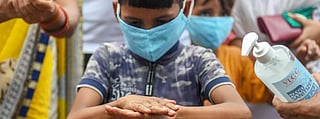
Reports about a sudden spike in pneumonia infections in children in north China evoke a sense of déjà vu of the COVID-19 pandemic that shook the entire world only a few years ago. While China has attributed the surge of cases in children to a pathogen called mycoplasma pneumoniae and says that the infections are falling, it has also warned that there might be a rise in respiratory illnesses in adults as this was the first winter since COVID-19 restrictions were lifted. Here is all we know so far about the mycoplasma-induced respiratory illness that was reported in children.
Mycoplasma pneumoniae is a bacteria that commonly causes mild respiratory illnesses. The bacteria usually causes mild illness in children but can escalate to a lung infection. It mainly spreads if a person comes in contact with droplets of an infected person, expelled while coughing or sneezing. An outbreak of mycoplasma pneumoniae usually occurs in crowded settings like educational institutions, homes and hospitals.
The main symptoms of the infection are synonymous with what happens in common respiratory illnesses: fever, headache, sore throat, slowly worsening cough that can last for weeks or months, sneezing, stuffy or runny nose, watery eyes, vomiting, diarrhea, etc. While most people recover from the infection without any antibiotics, if a person develops a lung infection, they might need treatment. So it is recommended to visit a doctor if a person exhibits such symptoms.
While there is no vaccination to prevent a mycoplasma pneumoniae infection, there are certain hygiene practices that might help safeguard ourselves from catching the infection.
Covering our mouth and nose with a tissue or cloth while coughing or sneezing. If either is not available, sneeze or cough into the upper sleeve or elbow but not into our hands or palms.
Disposing of the used tissue or cloth immediately.
Washing our hands often with soap and water for at least 20 seconds, or using a hand sanitizer.
– On November 13, the China’s National Health Commission reported that there was a spike in respiratory illnesses, majorly in children, many of which required hospitalisations, resulting in longer waits in hospitals.
– On November 21, the Program for Monitoring Emerging Diseases (ProMED), a program of the International Society for Infectious Diseases (ISID) and launched in 1994 to conduct global reporting of infectious disease outbreaks, stepped in, revealing the outbreak of an “undiagnosed respiratory illness in several areas in China as Beijing and Liaoning are almost 800 km apart.” “It is not at all clear when this outbreak started as it would be unusual for so many children to be affected so quickly,” it said and noted it was not saying that any adults were affected, but suggesting some exposure at the schools. “ProMED awaits more definitive information about the etiology and scope of this concerning illness in China. It is too early to project whether this could be another pandemic,” it added.
– On November 22, the World Health Organisation (WHO) officially requested China to provide additional epidemiological and clinical information, and laboratory results of the cases reported. On November 23, China provided the data and informed WHO that the increase in such cases was “earlier in the season than historically experienced, but not unexpected given the lifting of COVID-19 restrictions”. They also informed the world body that there had been “no detection of any unusual or novel pathogens or unusual clinical presentations”.
Stating that the WHO was closely monitoring the situation and that it was in close contact with national authorities in China, the health body recommended people in China to follow measures to reduce the risk of respiratory illness, like wearing masks, maintaining physical distance from others, getting the necessary vaccine shots, etc. But it did not place any restrictions on travel or other things.
On November 26, the Union Ministry of Health and Family Welfare (MoHFW) said that the Government of India was closely monitoring the situation and that there was no need for any alarm. “The Union Health Ministry has proactively decided to review the preparedness measures against respiratory illnesses as a matter of abundant caution,” it said.
In a letter by the Union Health Secretary to States and Union Territories, the following measures have been suggested:
> Immediately review public health and hospital preparedness measures viz. availability of HR, hospital beds, drugs & vaccines for influenza, medical oxygen, antibiotics, personal protective equipment, testing kits and reagents, functionality of oxygen plants and ventilators, infection control practices in health facilities, at a senior level.
> Conduct integrated surveillance of respiratory pathogens presenting as cases of influenza like illness (ILI) and severe acute respiratory illness (SARI).
> Send nasal and throat swab samples of patients with SARI, particularly of children and adolescents, to Virus Research and Diagnostic Laboratories (VRDL’s) located in the States for testing for respiratory pathogens.
Join TNM and Newslaundry as we bring to you the most compelling reporting and analysis during the upcoming elections in Telangana, Mizoram, MP, Chhattisgarh, and Rajasthan. Click here to support our election coverage.